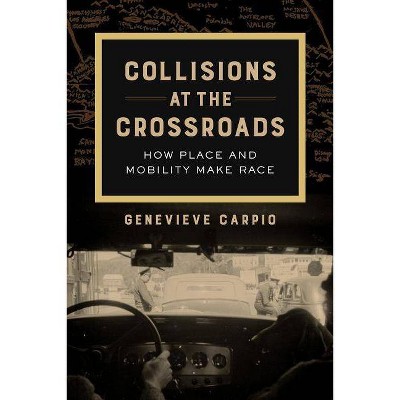Mean Streets, 27 - (American Crossroads) by Andrew J Diamond (Paperback)

Similar Products
Products of same category from the store
AllProduct info
<p/><br></br><p><b> About the Book </b></p></br></br>"In a city that social scientists feel we know well, "Mean Streets" provides new and exciting insights into the spatial dimensions of urban life. Not afraid to talk about both attraction and repulsion, Diamond provocatively unearths the critical role of youths--ages 15 to 25--in leading their wider communities in the negotiation of race."--George Sanchez, author of "Becoming Mexican American: Ethnicity, Culture, and Identity in Chicano Los Angeles 1900-1945" <BR>"In "Mean Streets," Andrew Diamond brilliantly bridges social, political, and cultural history. His deeply researched account of Chicago's black, white, and Latino youth subcultures offers a fresh perspective on the entangled histories of identity, power, and place. This is a first-rate book."--Thomas J. Sugrue, author of "Sweet Land of Liberty: The Forgotten Struggle for Civil Rights in the North." <BR>"This excellent social history of Chicago's youth gangs not only demonstrates their centrality to the vaunted community and turf consciousness of the city's neighborhoods; it also explains the widespread ethnic and racial conflict that has characterized the city for most of the twentieth century. Diamond accomplishes this with a remarkable amount of empirical research on the gritty streets, playgrounds and parks, dance halls, 'can houses' (brothels), and industrial wastelands in, between, and around these neighborhoods."--James R. Barrett, author of "Work and Community in 'The Jungle': Chicago's Packing House Workers, 1894-1922."<p/><br></br><p><b> Book Synopsis </b></p></br></br><i>Mean Streets</i> focuses on the streets, parks, schools, and commercial venues of Chicago from the era of the 1919 race riot to the civil rights battles of the 1960s to cast a new light on street gangs and to place youths at the center of the twentieth-century American experience. Andrew J. Diamond breaks new ground by showing that teens and young adults stood at the vanguard of grassroots mobilizations in working-class Chicago, playing key roles in the formation of racial identities as they defended neighborhood boundaries. Drawing from a wide range of sources to capture the experiences of young Mexicans, Puerto Ricans, African Americans, Italians, Poles, and others in the multiracial city, Diamond argues that Chicago youths gained a sense of themselves in opposition to others.<p/><br></br><p><b> From the Back Cover </b></p></br></br>In a city that social scientists feel we know well, <i>Mean Streets</i> provides new and exciting insights into the spatial dimensions of urban life. Not afraid to talk about both attraction and repulsion, Diamond provocatively unearths the critical role of youths--ages 15 to 25--in leading their wider communities in the negotiation of race.--George Sanchez, author of <i>Becoming Mexican American: Ethnicity, Culture, and Identity in Chicano Los Angeles 1900-1945</i><br /><br />In <i>Mean Streets</i>, Andrew Diamond brilliantly bridges social, political, and cultural history. His deeply researched account of Chicago's black, white, and Latino youth subcultures offers a fresh perspective on the entangled histories of identity, power, and place. This is a first-rate book.--Thomas J. Sugrue, author of <i>Sweet Land of Liberty: The Forgotten Struggle for Civil Rights in the North.</i><br /><br />This excellent social history of Chicago's youth gangs not only demonstrates their centrality to the vaunted community and turf consciousness of the city's neighborhoods; it also explains the widespread ethnic and racial conflict that has characterized the city for most of the twentieth century. Diamond accomplishes this with a remarkable amount of empirical research on the gritty streets, playgrounds and parks, dance halls, 'can houses' (brothels), and industrial wastelands in, between, and around these neighborhoods.--James R. Barrett, author of <i>Work and Community in 'The Jungle': Chicago's Packing House Workers, 1894-1922.</i><p/><br></br><p><b> Review Quotes </b></p></br></br><br><i>Mean Streets</i>is a deeply researched account of how youth gangs shaped neighborhood boundaries in Chicago.-- "American Quarterly" (12/1/2009 12:00:00 AM)<br><br>"A fascinating, meticulous, and entertaining account. . . . An important, engaging book."--Moira Hinderer "Journal Of American History" (6/20/2010 12:00:00 AM)<br><br>"Diamond contends that young Euro-American men forged their masculine and racial identities . . . around their encounters with the colour line."-- "Urban History" (6/24/2010 12:00:00 AM)<br><br>"Diamond's book makes considerable contributions to multiple fields of scholarship."--Christopher E. Manning "American Historical Review" (6/1/2011 12:00:00 AM)<br><br>"Diamond's engaging writing allows him to weave a rich tapestry about life in this multiracial city."-- "Journal Of African American History" (3/15/2011 12:00:00 AM)<br><br>"Sugrue, Hirsch, Robert Self, and now Diamond...offer sophisticated understandngs of the origins of 'a new configuration of inequality with rearranged features'."-- "Journal Of Urban History" (4/20/2011 12:00:00 AM)<br><br>A book that will prove central to understanding Chicago, urban culture, and the role that youth gangs have played in their development.-- "H-Net Reviews" (5/8/2011 12:00:00 AM)<br><br>In Mean Streets Andrew J. Diamond offers a fascinating, meticulous, and entertaining account of the relationship between youths, street culture, race, and racial violence in twentieth-century Chicago.-- "Journal Of American History" (6/1/2010 12:00:00 AM)<br><p/><br></br><p><b> About the Author </b></p></br></br><b>Andrew J. Diamond </b>is Associate Professor of American History and Civilization at the Université Charles de Gaulle - Lille 3 in France.
Price History
Price Archive shows prices from various stores, lets you see history and find the cheapest. There is no actual sale on the website. For all support, inquiry and suggestion messagescommunication@pricearchive.us




















